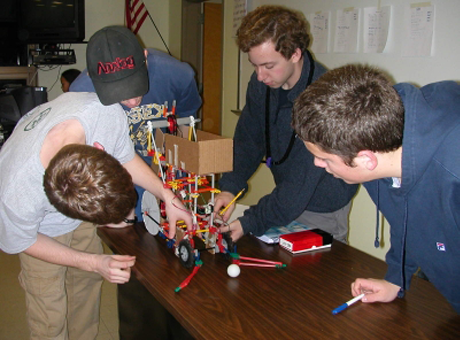Essex High School InvenTeam
A tennis match or practice can be hindered by the inevitable task of picking up tennis balls that accumulate on the court. Tennis courts are often expensive to reserve, so wasting time is costly. In addition, constant bending over to gather balls can strain one's back. The team proposed the "RoboScooper," a robotic tennis ball retriever, to collect balls on the court and bring them to a base station. The station would feed into a ball lobber for players who practice alone. Overall, the robot would save players time on the tennis courts. The RoboScooper is a robotic system that uses two rovers to find and collect tennis balls. Each rover retrieves up to twenty balls and brings them to a base station, where the tennis balls are then raised 4 foot 6 inches and then either dropped into a storage device or loaded into a ball lobber. Rover programs are chosen remotely to instruct the rovers where to search for balls. The manufacturing cost for the base station is $500 and the cost of each rover is $400. The Essex High School InvenTeam researched ball-retrieving machines and discovered there were no machines with the capabilities proposed for the RoboScooper. The team split into groups to focus on different aspects of the invention. The two rover groups first brainstormed ideas for different rovers and methods of retrieving balls. The base station group worked on the central robot and developed the base station. The navigation and communication group worked to develop a navigation system for the rovers and the base station. The sensor group experimented with sensors that would be used in navigation and later merged with the navigation and communication group. Each group worked to find usable parts for the robots. The students created many models using consumer robots and household items and goods. For the final prototype the team used microcontrollers from the Atmel Corporation, along with Zagros motors and w heels. The team received support from the University of Vermont's College of Engineering, Queen City Steel, and the Hazelett Strip-Casting Corporation. The Essex High School InvenTeam plans to refine navigational problems with the rovers and enable the RoboScooper to recognize the number of balls each rover collects. They also want to enable the rovers to feed into a ball lobber, which they had initially envisioned.


